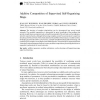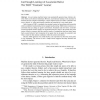112
Voted
NPL
2002
15 years 9 days ago
2002
The learning of complex relationships can be decomposed into several neural networks. The modular organization is determined by prior knowledge of the problem that permits to split...
135
Voted
AIR
2006
15 years 21 days ago
2006
Abstract. An over-zealous machine learner can automatically generate large, intricate, theories which can be hard to understand. However, such intricate learning is not necessary i...
87
Voted
COMPSAC
2004
IEEE
15 years 4 months ago
2004
IEEE
In this paper we describe the process of mining complex relationships in spatial databases using the Maximal Participation Index (maxPI), which has a property of discovering low s...
93
Voted
ICDM
2003
IEEE
15 years 6 months ago
2003
IEEE
This paper describes the need for mining complex relationships in spatial data. Complex relationships are defined as those involving two or more of: multi-feature co-location, sel...
143
Voted
ICCS
2005
Springer
15 years 6 months ago
2005
Springer
Abstract. Morphisms constitute a general tool for modelling complex relationships between mathematical objects in a disciplined fashion. In Formal Concept Analysis (FCA), morphisms...
96
Voted
ICDM
2007
IEEE
15 years 7 months ago
2007
IEEE
Most algorithms for mining interesting spatial colocations integrate the co-location / clique generation task with the interesting pattern mining task, and are usually based on th...


